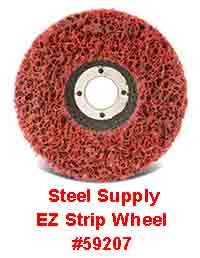There are an unlimited number of brands and types of Shop Coat Primer for the Steel Fabricator to choose from. Levels of quality vary greatly and different systems can be called out on shop drawings. They will range from the basic Red Oxide or Gray shop coat, with no additional requirements to the more complex and much more expensive 2-part systems, High Solids Rust Inhibitives and Universal Primers.
 There is one thing all systems have in common. Proper surface preparation will improve the performance of the coating. As Steel Fabricators, we are all familiar with the conditions steel presents. mill scale, rust, surface contaminants like cutting oil, dampness and even the difference in temperature between the air and the steel.
There is one thing all systems have in common. Proper surface preparation will improve the performance of the coating. As Steel Fabricators, we are all familiar with the conditions steel presents. mill scale, rust, surface contaminants like cutting oil, dampness and even the difference in temperature between the air and the steel.
Depending on the types of work a fabricator does, their paint area may be very experienced in how the primer coats work. Shops focused on bridge work, exposed steel, oil refineries, specialized fabrication, etc. usually have more developed paint departments well versed in primer systems and surface preparation. The fabricators doing lower tonnage and private jobs will usually stick to basic shop coats. Either way, a good familiarity with surface preparation will help prevent coating failures.
 Now known as The Society for Protective Coatings, the Steel Structures Painting Council (SSPC) was founded in 1950 to advance the use of coatings to protect steel structures. The surface preparation standards they have developed can be broken down into the basic categories below.
Now known as The Society for Protective Coatings, the Steel Structures Painting Council (SSPC) was founded in 1950 to advance the use of coatings to protect steel structures. The surface preparation standards they have developed can be broken down into the basic categories below.
SSPC-SP1 Solvent Cleaning
Removal of all visible oil, grease, soil, drawing and cutting compounds, and other soluble contaminants from steel surfaces with solvent, vapor, cleaning compound, alkali, emulsifying agent, or steam.
(Steel Supply Note – If the primer being applied is latex/water based caution should be exercised to avoid cleaning with oil based solvents. They can leave a residue on the steel surface that the water based primer may not penetrate. This will cause the primer to peel off when dry.)
SSPC-SP2 Hand Tool Cleaning
Removes all loose mill scale, loose rust, loose paint, and other loose detrimental foreign matter by hand chipping, scraping, sanding, and wire brushing.
 SSPC-SP3 Power Tool Cleaning
SSPC-SP3 Power Tool Cleaning
Removes all loose mill scale, loose rust, loose paint, and other loose detrimental foreign matter by power wire brushing, power sanding, power grinding, power tool chipping, and power tool descaling.
SSPC-SP5 / NACE 1 White Metal Blast Cleaning
When viewed without magnification, the surface shall be free of all visible oil, grease, dust, dirt, mill scale, rust, coating, oxides, corrosion products and other foreign matter.
SSPC-SP6 / NACE 3 Commercial Blast Cleaning
When viewed without magnification, the surface shall be free of all visible oil, grease, dust, dirt, mill scale, rust, coating, oxides, corrosion products and other foreign matter of at least 66-2/3% of unit area, which shall be a square 3 in. x 3 in. (9 sq. in.). Light shadows, slight streaks, or minor discolorations caused by stains of rust, stains of mill scale, or stains of previously applied coating in less than 33-1/3% of the unit area is acceptable.
The SSPC Surface Preparation Standards continue from SP-7 to SSPC-SP14. These are specific to coating systems that are not often used in construction based Structural and Miscellaneous steel fabricating. When steel is required to be coated using these surface preparations fabricators will often refer that portion of the job to an SSPC Contactor.
For a full list of SSPC Surface Preparation Standards, click here.





